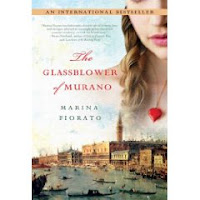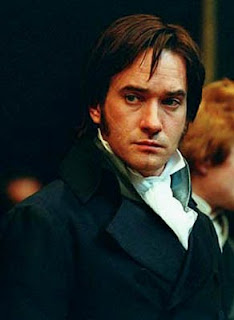And this big, fluffy feather skirt of Karina's this week--It. Will. Be. Mine. RWA conference 2010 is going to be Feather Skirt Time.


An historical author shares her obsessions with books, tea, chocolate, wine, and whatever takes her fancy!



 This weekend we'll look at one of my favorite poets, Elizabeth Barrett Browning, since the anniversary of her elopement with Robert Browning was last weekend! (They married in 1846).
This weekend we'll look at one of my favorite poets, Elizabeth Barrett Browning, since the anniversary of her elopement with Robert Browning was last weekend! (They married in 1846). In 1838, at her doctor's advice, Elizabeth went to live for a time at Torquay along with her brother Edward. His death by drowning there in 1840 sent her into a terrible downward spiral, and she returned to Wimpole Street as an invalid and recluse, kept company mostly by her beloved spaniel Flush. She kept writing, though, and in 1844 two volumes were published, A Drama of Exile, a Vision of Poets and Lady Geraldine's Courtship. These volumes made her one of the most popular writers of the time and inspired Robert Browning to write her a fan letter. Kenyon arranged for them to meet in May 1845, and thus began the most famous courtship in literary history.
In 1838, at her doctor's advice, Elizabeth went to live for a time at Torquay along with her brother Edward. His death by drowning there in 1840 sent her into a terrible downward spiral, and she returned to Wimpole Street as an invalid and recluse, kept company mostly by her beloved spaniel Flush. She kept writing, though, and in 1844 two volumes were published, A Drama of Exile, a Vision of Poets and Lady Geraldine's Courtship. These volumes made her one of the most popular writers of the time and inspired Robert Browning to write her a fan letter. Kenyon arranged for them to meet in May 1845, and thus began the most famous courtship in literary history. Elizabeth Barrett Browning died on June 29, 1861 and was buried at the English Cemetery in Florence.
Elizabeth Barrett Browning died on June 29, 1861 and was buried at the English Cemetery in Florence.













 One thing I love about doing these "heroine weekends" is finding out about extraordinary women I knew nothing about before. (Plus finding inspiration for future heroines in my own books!) This weekend we look at Sarah Frances Whiting, who died on this day in 1927 and was a pioneer for women in science in the United States.
One thing I love about doing these "heroine weekends" is finding out about extraordinary women I knew nothing about before. (Plus finding inspiration for future heroines in my own books!) This weekend we look at Sarah Frances Whiting, who died on this day in 1927 and was a pioneer for women in science in the United States. In 1877, Durant introduced her to Professor Edward Pickering at MIT and director of Harvard's Observatory. He invited her to MIT to observe the undergrad physics lab there and attend physics lectures (which were otherwise closed to women). She went on to use this information to establish, equip, and operate a physics lab at Wellesley, the only lab of its kind for women in the US. In 1879, she went to inspect the Harvard Observatory, which was being used for astronomical investigations (particularly in the field of spectroscopy, which allowed for the observation of the patterns of spectra--lines and bands--that form when light is sent through a prism). This inspired her to integrate astronomy into the Wellesley curriculum. She created and taught the first course in 1880 under the title "Applied Physics." She also set herself the large task of having an observatory installed at the college, with the fundraising help of Wellesley trustee Mrs. John C. Whittin. The Whitin Observatory was built by converting an old organ loft on the fifth floor of College Hall, and it was opened in 1900 (with Whiting again designing and ordering the equipment herself).
In 1877, Durant introduced her to Professor Edward Pickering at MIT and director of Harvard's Observatory. He invited her to MIT to observe the undergrad physics lab there and attend physics lectures (which were otherwise closed to women). She went on to use this information to establish, equip, and operate a physics lab at Wellesley, the only lab of its kind for women in the US. In 1879, she went to inspect the Harvard Observatory, which was being used for astronomical investigations (particularly in the field of spectroscopy, which allowed for the observation of the patterns of spectra--lines and bands--that form when light is sent through a prism). This inspired her to integrate astronomy into the Wellesley curriculum. She created and taught the first course in 1880 under the title "Applied Physics." She also set herself the large task of having an observatory installed at the college, with the fundraising help of Wellesley trustee Mrs. John C. Whittin. The Whitin Observatory was built by converting an old organ loft on the fifth floor of College Hall, and it was opened in 1900 (with Whiting again designing and ordering the equipment herself).
 I'm also at the Riskies today, talking about the mystery of the death of Amy Robsart...
I'm also at the Riskies today, talking about the mystery of the death of Amy Robsart...














 In 1723, Maria was on a short-list of eligible young ladies who might marry the young Louis XV. He had been betrothed for a time to a Spanish infanta, but she was a child and it was thought France needed heirs sooner rather than later. (Plus there were factions at Court that didn't want complicated political alliances with foreign powers). They married in 1723, and her name was Frenchified to Marie Leczinska.
In 1723, Maria was on a short-list of eligible young ladies who might marry the young Louis XV. He had been betrothed for a time to a Spanish infanta, but she was a child and it was thought France needed heirs sooner rather than later. (Plus there were factions at Court that didn't want complicated political alliances with foreign powers). They married in 1723, and her name was Frenchified to Marie Leczinska. Marie died in 1768, six years before her husband, and his newest mistress Madame du Barry moved in and took over. Her death was deeply grieved by her children and grandchildren, who adored her, and she was known from then on as Bonne Reine Marie (Good Queen Marie).
Marie died in 1768, six years before her husband, and his newest mistress Madame du Barry moved in and took over. Her death was deeply grieved by her children and grandchildren, who adored her, and she was known from then on as Bonne Reine Marie (Good Queen Marie).